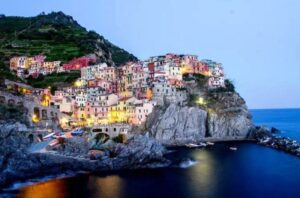THE SPECTACULAR BEAUTY OF ITALY’S CINQUE TERRE
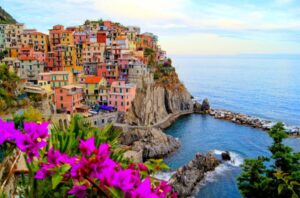
A century ago, the Cinque Terre were simply five fishing villages on an unforgiving, incredibly rugged stretch of the Ligurian coast of northwest Italy. With modern transport came tourism, and now hordes arrive daily to experience it all: the startlingly vibrant colour of the Mediterranean, the wildly rugged coastline, scenic hiking tracks and the tiny towns tucked into the dramatically steep valleys.

The Ligurian coast has many unique destinations ranging from the port city of Genoa to the cliff-hanging Alassio, but the most outstanding of them all are the Cinque Terre (five towns). The area has been populated since the Bronze Age and played an important role in the geographical strategy of Ancient Rome, given its location on the Mediterranean was ideal for commerce and trade. Exploring Cinque Terre’s colourful towns has not always been within easy reach. Fortunately, with improvements in transport and access, today it’s one of the most visited places in Italy, with up to 2.40 million people a year travelling to the Cinque Terre National Park and UNESCO World Heritage Site.
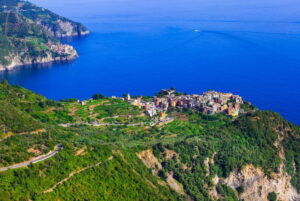
The Cinque Terre is mentioned in documents dating back to the 11th century, although it’s history is known to date back to the Bronze Age. In medieval times it was described as “the five castles”. Tiny communities like this grew up in the protective shadows of their castles—the people ready to run for refuge at the first hint of invasion or raiders. Over the centuries people have built terraces on the rugged, incredibly steep landscapes, right up to the cliffs that overlook the Ligurian Sea. Paths, a good train service and ferries connect the villages, although cars can only reach them with great difficulty from outside the area via narrow and precarious roads. When you see these roads, it’s understandable that visitors area actively discouraged from attempting access by car, and in fact cars have been banned within the villages for more than a decade. Drivers will also discover that any parking possibilities lie more than 1 km from each village. Another reason not to try and take a car.
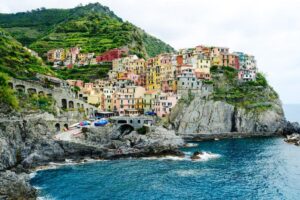
Cinque Terre begins behind the Punta Mesco promontory, where the gulf of Monterosso opens up the first of the five towns. The villages of Monterosso and Vernazza were the first to be settled in Roman times. The other villages grew later, all within the territory of the Republic of Genoa, although its oldest core, on the hill of San Cristoforo, began to play a significant role in the 7th century during the Lombard attacks. Then in the 9th century, the Saracens occupied the region and demolished the small villages in the area, causing the local people to flee.
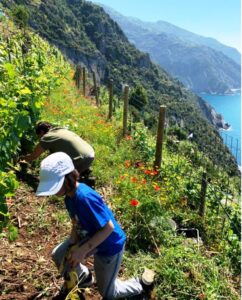
In the 11th century, the Tuscan Obertengo family finally ousted the Saracens. The locals moved back down to the sea and constructed their first houses. These returned inhabitants started a heroic work that we still admire today. They turned the natural forests and rough, steep slopes into cultivated terraces, built dry stone walls and planted vines.
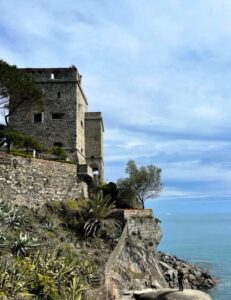
The villages were often under attack by pirates, so guards kept watch on the sea from the many watchtowers spaced along the coast. The success of these measures allowed maritime trade to commence. Nevertheless, the whole area was disputed between many noble families in the Middle Ages before being conquered by the Republic of Genoa in the 12th century, when it took two days to sail from the villages to Genoa. By this time, the coast had become famous for its excellent wine. In the 16th century the inhabitants reinforced existing forts and built new defence towers to defend the area from attacks by the Turks.
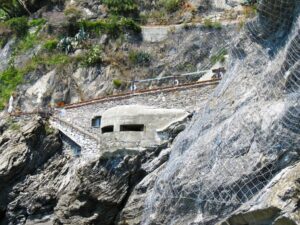
Cinque Terre experienced an economic decline from the 17th to 19th centuries, and only started to recover when an arsenal was built in the nearby town of La Spezia. A rail link to Genoa was built after the unification of Italy in 1870, when the coastal line between Genoa and Rome passed through the Cinque Terre, enabling the villages to be reached by train. Bombing and fighting during WWII caused extensive damage to Cinque Terre and a number of locals were forced to leave. As well, the introduction of the railway led to further migration from the area and a decline in traditional industries, until the growth of tourism from the 1970s onwards brought some degree of prosperity.
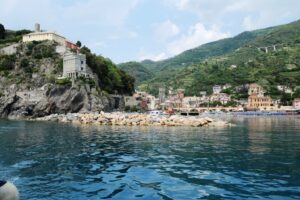
The predominant crops of the area have been grapes and olives. Some fishermen were based in Monterosso, but the area’s brightly painted fishermen’s cottages we see today were only dreamt up in the late 1970s as a tourist attraction. Because of its exceptional cultural and ecological assets, UNESCO added Cinque Terre to its list of World Assets Sites in 1997 and in 1999, the Cinque Terre National Park was established.
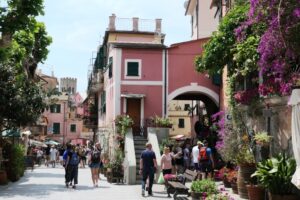
Monterosso al Mare is the largest and possibly the liveliest of the five villages. More a small town than a village, it’s divided into two parts, the old and the new, by a small tunnel that runs under the medieval Tower of Aurora, which is now home to an atmospheric restaurant. The old section, on the eastern side, is dominated by the ruins of the ancient fortress and castle and the 17th century Church of San Francesco, from which there are spectacular views of the aquamarine sea.
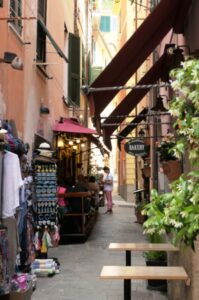
The old quarter is certainly the liveliest, distinguished mainly by the caruggi (narrow alleys typical of Liguria), where you will find wine bars, restaurants, gelato parlours, bakeries and small individual shops selling a wide variety of mostly tourist-focussed merchandise—much of which nevertheless is quite appealing. Anchovies of Monterosso are a local speciality designated with a Protected Designation of Origin status from the European Union.
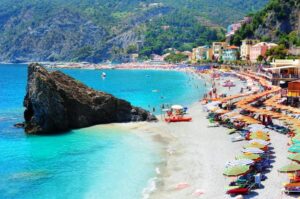
Without doubt, the beach is one of Monterosso’s best-known and sought-after attractions. Not just because it’s the only “sandy” (actually a mix of sand and pebbles) beach, but because of the much-photographed orange and green beach umbrellas that are available to rent. The more modern development on the western side also includes the railway station and other important facilities.
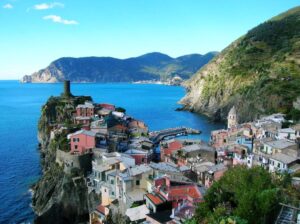
Heading south from Monterosso al Mare towards La Spezia, the second town you come to is Vernazza. Some refer to it as the pearl of the Cinque Terre, and along with Manarola, it’s registered among the most beautiful small villages of Italy (I borghi piu belli d’Italia). Its steep, narrow streets descend towards the main thoroughfare and end in a small square in front of the port, where much of the village’s life takes place.
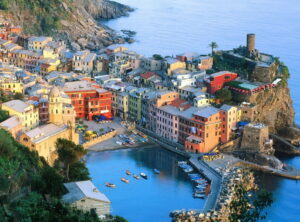
Vernazza was the only village with a natural harbour, so ships departed from here to the Republic of Genoa and other countries. As a result, Vernazza was the most prosperous village with economic and political power. This wealth is shown even today by beautiful arcades, archways and balconies. In medieval times, there was no main square, beach or breakwater, the waves were splashing at the houses. Boats were also moored against the walls, so Vernazza looked a little like Venice.
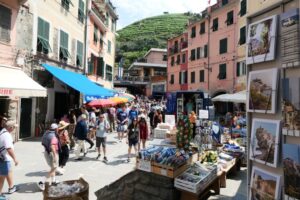
The focus of the village is the main street, with carruggi—small streets—running parallel with it. The main street runs to the main square, Piazza Marconi, which is the heart of the village, the “gossip corner” with several bars and restaurants, colourful houses, often with drying clothes hanging from them, boats, piles of fishing nets and lazy cats sunning themselves. Just by the piazza is a small sandy beach and a harbour.
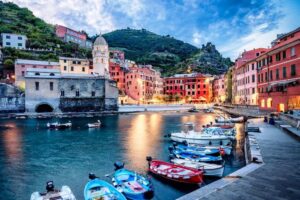
Have a look at the lovely church of Santa Margarita d’Antiochia on the main square, with its 40m high octagonal belltower, constructed in 1318 in the Ligurian Gothic style.
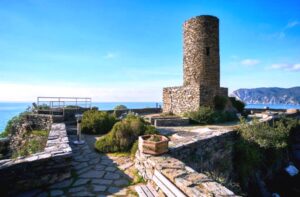
Vernazza’s defence system was built by the Genoans to protect Vernazza against Saracens, barbarian tribes and pirate attacks. Castles and bastions have been reinforced several times, and their remains can be seen today. On a rocky ridge on the edge of the village the round tower of the Castello Doria, once owned by a Genoan noble family, is still an important local landmark. From the remaining Belforte tower you can enjoy sweeping views of the village and its colourful harbour. During WW ll, German forces used it an anti-aircraft station.
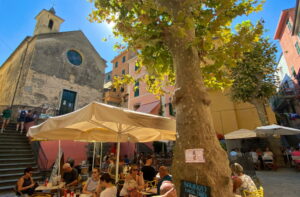
Clinging to the rocks overhanging the sea is Corniglia, the only village not directly in contact with the sea. As the village does not have a harbour, the ferries that ply up and down Cinque Terre therefore do not call in here. Standing on a high, rocky promontory intensively cultivated with vineyards, this little hamlet is 100m. above the sea, reached by a 377 step staircase from the main station. From Corniglia, you can explore the network of paths along the overhanging rocks—a real “balcony” over the whole Cinque Terre.
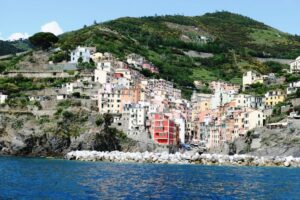
The next village, heading towards La Spezia, is Manarola. First mentioned in 1261, it is believed to have been founded by the inhabitants of Volastra, a village that existed in early Roman times. Volastra is located above Manarola on top of a hill, and during the Roman era, travellers used to change horses here. The residents of Volastra farmed the surrounding terraces, planted olive, lemon and chestnut trees as well as vines, then in the 12th century, part of the population moved down towards the sea and founded the village of Manarola. The name has a Roman origin: derived from a name of an altar dedicated to the Mani gods, “manium arula”. However, other sources say that its name derives from the words “magna roea”, meaning “a big mill wheel”.
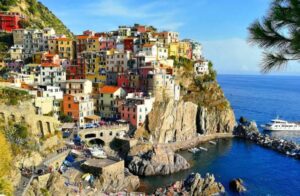
If you arrive from the railway station you’ll find a pedestrian tunnel which takes you to the main street of Manarola, the via Rollandi. The structure of the village develops like an amphitheatre along the course of the old stream that used to run, and small bridges connected the two sides. In the upper part of the village the stream can still be seen, along with some bridges. Walk all the way up to the square of the church, Piazza Papa Innocenzo IV, for an amazing view. Along the way you’ll also see an old mill wheel.
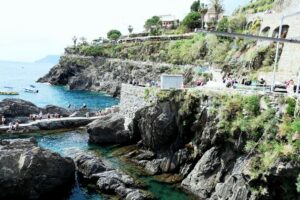
Heading towards the sea will bring you to Piazza Capellini, and on one side of the square you will see old photos of the village. In the lower part of the main street, fishing boats are parked just like cars in a typical town. At the end is the harbour, which seems hidden between two rocks. A popular swimming spot, its deep waters are full of fish, so it’s also popular for snorkeling. To enjoy the slow pace of Manarola, have an aperitivo on the seafront to watch the shades of the village warm up as the sun goes down. Immediately after sunset, a multitude of lights from the various houses light up the village again, reminiscent of a Christmas creche display.
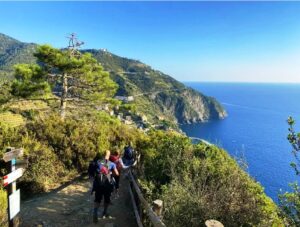
The southern-most village of the Cinque Terre is Riomaggiore, perhaps the most dramatic of them all. The village was built in the valley of the Rivus Maior (river), hence its name. It’s dominated by Mediterranean vegetation, an example of the beauty of Cinque Terre and its natural environment. From the main street, via Colombo, many sets of steps lead to small back alleys further up the hill. The main street and the railway station are connected by a long pedestrian tunnel, whose walls are covered in very pretty mosaics.
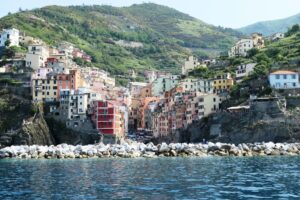
The two and three storey houses of Riomaggiore are painted in typical Ligurian colours. The houses have two entrances, one at the front, and one at the back, usually higher up. They were constructed this way not only because of the steep hills, but also for safety reasons, so that the inhabitants could escape in case of Saracen attacks. The steep, rugged cliffs that greet you if you arrive by sea, starkly contrast with the vibrant houses, whose red, orange and pink tones create a very picturesque landscape. There are many colourful small boats (Gozzi) and drying nets down by the sea, and the village has a great choice of many small seafood restaurants that serve traditional, local dishes based on the catch of the day.
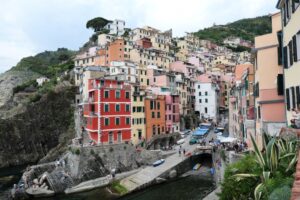
Riomaggiore’s Church of San Giovanni Battista, built in 1340, although its façade was rebuilt in a Neo-Gothic style in 1870, is well worth a look. There is a Castello that stands on top of the hill between the Rio Maggiore and the Rio Finale river valleys, said to be constructed in the 13th century. Nowadays, it’s a centre for cultural events and weddings. There are wonderful views from here. The Museo delle Cinque Terre Antiche (Museum of local history), is a museum about the origin and history of the Cinque Terre, the everyday life of locals, the real values of the area and why the Cinque Terre has become a UNESCO World Heritage site.
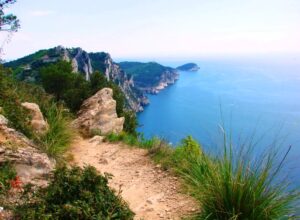
There are a couple of ways of accessing the five villages of Cinque Terre. Traditionally, the famous coastal hiking path, the Sentiero Azzurro (Blue path), begins in Riomaggiore. The first section, between Riomaggiore and Manarola, is called Via dell’Amore (Lovers’ path). The path eventually connects all the villages, but be aware that sections of the pathway are closed occasionally, due to rock slides, so do ask as you go about access along the way. If you decide to hike, be aware that it is mandatory to wear proper shoes, and that thongs and sandals are banned. For the most part, there is a fee for the hiking trails as they are within the national park of the Cinque Terre. The cost of a one day pass is around 8 Euros, and this pass is also valid for some of the buses in the national park.
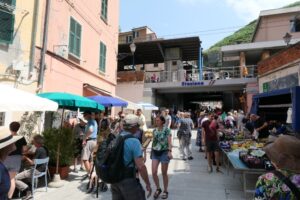
Many people visit Cinque Terre’s villages by train. The Cinque Terre Express trains run approx. every 20 mins. from mid March to first week of November, and during winter months, operate once or twice an hour. The trains run between the villages stopping at Levanto at the northern end, then the villages of Monterosso, Vernazza, Corniglia, Manarola, Riomaggiore and lastly at the town of La Spezia. Just be aware though that there are a lot of tunnels to pass through en route, meaning that views are constantly interrupted. A Cinque Terre Train Card costs around 18.20 Euros for a one day pass for unlimited train trips. Always remember to validate your ticket at the green stamp machine located in the stairs on the way to the platform. Fines are quite expensive if you forget!
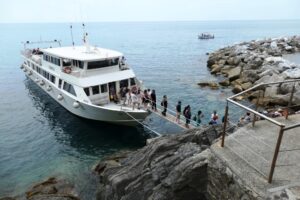
Alternatively, there is the regular ferry service, which we chose to take. In our view, it seemed the best way to appreciate the impact of the geography of villages. This was a great decision. It was a wonderful experience, as the view, looking up at the villages clinging onto the steep cliffs, is best appreciated from the water. Boats run between 01 April to end of October, but it also depends on the weather and sea conditions. Frequency varies by the season. In summer there are about 10 daily. In low season, about 5 daily.
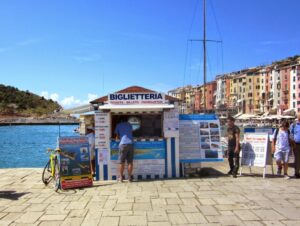
The boats run between Monterosso and Portovenere, and also further along to La Spezia, in both directions, and stop at each village except for Corniglia, since it doesn’t have a harbour—take the train to visit this village. You can also take a boat tour from Portovenere around the 3 islands or travel to Levanto or Lerici. A day pass for the Cinque Terre villages costs around 30 Euros. You can also get an afternoon pass for 23 Euros. The villages are quite close to each other, and ferry times between them is around 20 mins.
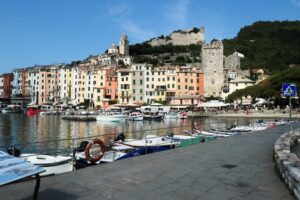
Regarding accommodation, each village has a limited range of accommodation to choose from. Just think carefully about accessing them with luggage in tow, since each village is perilously steep. Our recommendation is to stay in Portovenere, (or Porto Venere) a very pretty, medieval gem of a town from where you can catch the ferries, although it does not have a train station. If you wish to take a train, consider taking the ferry to the nearest village, Riomaggiore, or perhaps the walking path. You can also take a bus from La Spezia, or drive to Portovenere easily, as most accommodation has either on-site parking or close by. There’s a very good selection of cafes and restaurants offering a very good standard of food dotted along the waterfront and in the heart of the village, which is hidden behind the facades of the waterfront buildings.
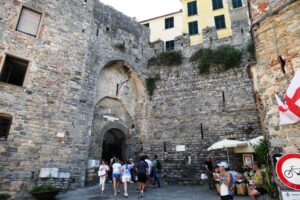
You enter the medieval village through Porta del Borgo, the old city gate. The little harbour is in a beautiful location overlooking the nearby Palmaria Island. Situated high on the hill and overlooking the Bay of Poets on one side and the Ligurian Sea on the other, Castello Doria is a must to see in Portovenere. It’s quite a steep climb to get there, but well worth the effort. The views from the gardens are phenomenal and justify the small entrance fee. Next to the Castello, San Pietro church has the best location in town. Perched on top of the rock and surrounded by the azure blue water from three sides, it looks like a fortified castle.
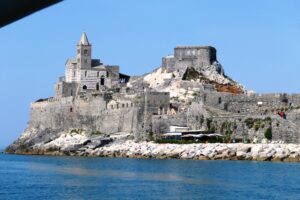
Next to San Pietro you can see an observation deck next to Lord Byron’s Grotto (previously Grotta Arpaia). The Bay of Poets is so named because the area was beloved by English poets. Lord Byron often stayed here, and he used to swim across the bay to visit his fellow poet, Shelley.
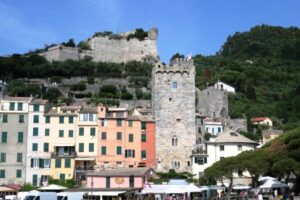
La Spezia is simply a large town, with a range of accommodation, as well as rental car agencies and a train line that connects with lines for the rest of Italy. Compared with sheer beauty and attractions of Portovenere and the villages, La Spezia isn’t a great option, in our view.
